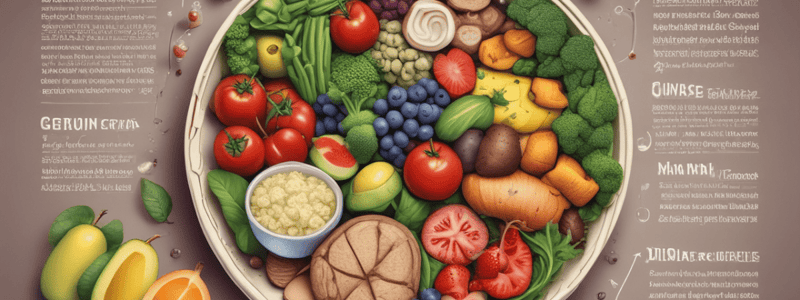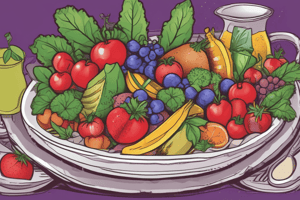Podcast
Questions and Answers
What are the primary macronutrients found in grains?
What are the primary macronutrients found in grains?
- Fat and fiber
- Carbohydrate (starch) and protein (correct)
- Protein and fiber
- Carbohydrate and fat
What is the recommended choice for grains according to dietary guides?
What is the recommended choice for grains according to dietary guides?
- Ultra-processed grains
- Refined grains
- Whole grains (correct)
- Minimally processed grains
What is the serving size of a grain food according to the USDA?
What is the serving size of a grain food according to the USDA?
- 1 cup of cooked pasta
- ½ cup of cooked rice
- 2 slices of bread
- 1 slice of bread (correct)
Why are cornmeal and popcorn grouped with grain products?
Why are cornmeal and popcorn grouped with grain products?
What is the purpose of dietary guides?
What is the purpose of dietary guides?
Why do nutrition experts develop dietary guides?
Why do nutrition experts develop dietary guides?
What are the major food groups typically classified into?
What are the major food groups typically classified into?
What is the main ingredient of pasta, noodles, and flour tortillas?
What is the main ingredient of pasta, noodles, and flour tortillas?
What is the definition of whole grains according to the FDA?
What is the definition of whole grains according to the FDA?
What is the purpose of enrichment in grain processing?
What is the purpose of enrichment in grain processing?
What is the difference between fat-free milk and whole milk?
What is the difference between fat-free milk and whole milk?
What is a good source of calcium, protein, phosphorus, and riboflavin?
What is a good source of calcium, protein, phosphorus, and riboflavin?
What is the purpose of fortification in food processing?
What is the purpose of fortification in food processing?
What is a protein-rich food that can substitute for meat?
What is a protein-rich food that can substitute for meat?
What is the difference between low-fat milk and fat-free milk?
What is the difference between low-fat milk and fat-free milk?
What group of foods includes fresh, dried, frozen, sauced, and canned fruit?
What group of foods includes fresh, dried, frozen, sauced, and canned fruit?
What is a serving size of food from the protein group?
What is a serving size of food from the protein group?
Why are dairy products recommended to have most of the fat removed?
Why are dairy products recommended to have most of the fat removed?
What is one serving of food from the fruit group equal to?
What is one serving of food from the fruit group equal to?
Why are whole or cut-up fruits healthier options than juices?
Why are whole or cut-up fruits healthier options than juices?
What is true about the nutritional content of foods within each group?
What is true about the nutritional content of foods within each group?
What is included in the oils group?
What is included in the oils group?
What is true about sugary foods and beverages?
What is true about sugary foods and beverages?
What happens to raw carrots when they are refrigerated?
What happens to raw carrots when they are refrigerated?
What is true about solid fats?
What is true about solid fats?
Why are canned carrots considered minimally processed foods?
Why are canned carrots considered minimally processed foods?
What is an example of a food that is classified as an 'other' vegetable?
What is an example of a food that is classified as an 'other' vegetable?
Why are peanuts and peanut butter classified as oils?
Why are peanuts and peanut butter classified as oils?
What is the primary purpose of additives in ultra-processed foods?
What is the primary purpose of additives in ultra-processed foods?
What is the concern of nutrition experts regarding ultra-processed foods?
What is the concern of nutrition experts regarding ultra-processed foods?
How can consumers determine if a food is minimally processed or ultra-processed?
How can consumers determine if a food is minimally processed or ultra-processed?
What is characteristic of an ultra-processed food?
What is characteristic of an ultra-processed food?
Why are dry beans often classified with meat?
Why are dry beans often classified with meat?
What is the difference between a minimally processed food and an ultra-processed food?
What is the difference between a minimally processed food and an ultra-processed food?
What is the first ingredient in the commercially made carrot cake shown in Figure 3.5b?
What is the first ingredient in the commercially made carrot cake shown in Figure 3.5b?
As of July 2020, what was the status of the FDA's standard definitions for categorizing processed foods?
As of July 2020, what was the status of the FDA's standard definitions for categorizing processed foods?
Flashcards are hidden until you start studying
Study Notes
Major Food Groups
- Major food groups are classified based on their natural origins and key nutrients, and include:
- Grains (e.g. wheat, rice, oats)
- Dairy products (e.g. milk, yogurt, cheese)
- Fruits (e.g. fresh, dried, frozen)
- Vegetables (e.g. fresh, cooked, canned)
- Protein-rich foods (e.g. beef, pork, lamb, fish, shellfish, poultry, beans, eggs, nuts, seeds)
- Each food group has specific serving sizes and recommendations for daily intake.
Grains
- Include products made from wheat, rice, and oats (e.g. pasta, noodles, flour tortillas)
- A serving of grain food is equivalent to 1 slice of bread, 1 cup of ready-to-eat cereal, or ½ cup of cooked rice, pasta, or cereal
- Whole grains are preferred over refined grains because they contain more fiber and nutrients
- Refined grain products are commonly consumed in the US and can be good sources of vitamins and minerals when enriched or fortified.
Dairy Products
- Include milk and products made from milk that retain their calcium content after processing (e.g. yogurt, hard cheeses)
- Excellent sources of protein, phosphorus, and riboflavin
- Fortified with vitamins A and D
- Milk-based desserts (e.g. ice cream, pudding, frozen yogurt) are often grouped with dairy products but are high in added sugar and fat
- Nonfat or low-fat milk is recommended over whole milk due to lower fat content.
Protein-Rich Foods
- Include beef, pork, lamb, fish, shellfish, poultry, beans, eggs, nuts, and seeds
- Serving sizes vary, but generally equal 1 ounce of meat, poultry, or fish, or ¼ cup cooked dry beans or dry peas
- Excellent sources of micronutrients, especially iron, zinc, and B vitamins
- Dry beans and peas, eggs, tofu, nuts, and seeds are protein-rich foods that can substitute for meat.
Fruits and Vegetables
- Fruits include fresh, dried, frozen, sauced, and canned fruit, and 100% fruit juice
- Vegetables include fresh, cooked, canned, frozen, and dried/dehydrated vegetables, and 100% vegetable juice
- Serving sizes vary, but generally equal 1 cup of fruit or fruit juice, or ½ cup of dried fruit
- Excellent sources of phytochemicals, fiber, and micronutrients
Other Foods
- Oils include canola, corn, and olive oils, as well as other fats that are liquid at room temperature
- Solid fats, such as beef fat, butter, and stick margarine, are high in saturated fats and associated with cardiovascular disease
- Sugary foods ("sweets") include candy, regular soft drinks, jelly, and other foods high in added sugar
- Alcohol-containing beverages are another source of empty calories.
Levels of Food Processing
- Raw foods can undergo different levels of processing, including refinement, before they are eaten
- Minimally processed foods, such as canned carrots, typically contain few refined ingredients
- Ultra-processed foods, such as frozen carrot cake, contain numerous additives to extend shelf life, enhance flavor, texture, color, and convenience
- Nutrition experts are concerned about the long-term negative health effects of eating diets high in ultra-processed foods.
Studying That Suits You
Use AI to generate personalized quizzes and flashcards to suit your learning preferences.




